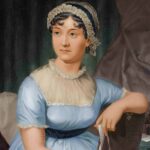
Jonathan Swift: Exploring the Satirical Genius of a Literary Icon
Born: 30 November 1667
Died: 19 October 1745
Country: Ireland
Notable works: A Tale of a Tub, Drapier’s Letters, Gulliver’s Travels, A Modest Proposal
Jonathan Swift, an Irish author, essayist, and poet, is celebrated for his satirical wit and mastery of prose. Born in Dublin, Ireland, in 1667, Swift’s formative years were deeply influenced by the political tensions of Ireland under English rule, a backdrop that would later permeate his writings. Swift’s literary contributions, notably marked by a critical eye on society and politics, transcended mere entertainment to offer profound commentary on the human condition and power structures.
Navigating the cultural and political landscapes of both England and his native Ireland, Swift’s identity as both a man and a writer was shaped by his experiences in these distinct environments. In addition to his literary pursuits, Swift also served as a clergyman in the Church of Ireland, a role that paralleled his continuous engagement with various literary forms, including essays and poetry, showcasing his versatility as a writer.
Swift’s enduring legacy is underscored by Gulliver’s Travels, a work that, while celebrated for its imaginative narrative, primarily serves as a vehicle for Swift’s incisive social and political insights. Contrary to the notion that it has become merely a beloved children’s classic, Gulliver’s Travels was originally intended for adults, filled with satirical allegories that critique human nature, politics, and society. Through his vivid storytelling and masterful use of irony, Swift’s impact on English literature remains profound, with his works continuing to be revered for their depth and insightful humor.
1. Early Life and Education
Jonathan Swift’s formative years were distinguished by a robust education and the influence of significant figures, laying the foundation for his future as a celebrated satirist and author.
1.1. Trinity College Dublin Experience
Born on November 30, 1667, in Dublin, Ireland, Swift embarked on his higher education journey at Trinity College, Dublin, in 1682. Despite the political upheaval leading to the college’s temporary closure in 1689, Swift was awarded his Bachelor of Arts degree by special grace. His tenure at Trinity College honed his critical thinking skills, a pivotal step towards his further studies at Oxford University, where he earned his Master of Arts in 1692.
1.2. Kilkenny College and Early Influences
Prior to his time at Trinity, Swift was educated at Kilkenny College from 1674 to 1682, a prestigious institution that provided him with a foundational education. His formative years at Kilkenny, surrounded by peers who would later achieve their own fame, nurtured a sense of ambition and competitiveness within Swift.
1.3. Mentorship under Sir William Temple
Jonathan Swift’s intellectual and literary development was significantly shaped by his tenure as a secretary to Sir William Temple, a retired diplomat and esteemed essayist, at Moor Park in England. This mentorship, which began around 1689 and, despite a brief hiatus in the early 1690s, continued until Temple’s death in 1699, exposed Swift to an extensive library and an intellectual environment that profoundly influenced his writing style and perspectives. During this period, under Temple’s guidance, Swift delved into satirical writing, laying the groundwork for the literary career that would bring him lasting fame. This mentorship was crucial in developing the critical and satirical prowess that characterized Swift’s later celebrated works.
2. Literary Career
Jonathan Swift’s literary career, spanning the early 18th century, is distinguished by his acute critique of contemporary society and politics, achieved through masterful satire and irony. Swift’s literary journey began with significant works that immediately positioned him as a formidable satirist and social commentator.
2.1. A Tale of a Tub and The Battle of Books
Swift’s early reputation as a master satirist was cemented with these publications, offering sharp critiques of religious extremes and a spirited defense of ancient over modern literature, respectively.
2.2. Satirical Works and Essays
- Drapier’s Letters (1724): A series of pamphlets showcasing Swift’s political satire and advocacy for Irish economic independence.
- A Modest Proposal (1729): A satirical essay proposing that the Irish poor sell their children as food, highlighting British exploitation and the dire poverty in Ireland.
2.3. Gulliver’s Travels and Prose Works
Jonathan Swift’s magnum opus, a complex satire under the guise of a travel narrative, explores human nature’s follies through the protagonist’s adventures. While initially popular as an adventure story, its enduring legacy lies in its deep political, social, and philosophical commentary.
3. Political Engagement and Pamphleteering
Jonathan Swift was also a political pamphleteer who fervently articulated his views on the politics of his time. Engaging in public discourse, Swift’s influential writings contributed to the debate surrounding the Glorious Revolution and the shifting allegiances between the Tories and other political factions.
3.1. Irish Causes and Drapier’s Letters
Swift championed Irish causes with vigor, most notably through his Drapier’s Letters. These pamphlets addressed the exploitation of the Irish economy by the English government. In a series of seven letters, Swift adopted the persona of Drapier to criticize the introduction of debased copper coinage, which he argued would devalue Ireland’s already weak currency and further impoverish the Irish people. The letters, laced with satirical wit, rallied the Irish public and forced the English government to rescind the patent granted to the coiner, William Wood, effectively making Swift a national hero in Ireland.
3.2. The Conduct of the Allies and Political Stance
Jonathan Swift’s pamphlet The Conduct of the Allies was published in 1711, at a time when the War of the Spanish Succession was nearing its end. He scrutinized the ongoing war efforts and criticized the Whig government for its management of the war and for extending the conflict beyond its necessity. Swift argued that the war was being prolonged not for national interests but to profit war contractors and financiers. This sentiment resonated with the Tories, who were calling for peace.
The pamphlet significantly influenced public opinion and played a role in leading to the Treaty of Utrecht, which ended the war in 1713. Swift’s Tory political stance was clear; he believed in a more conservative approach and was critical of the Whigs’ policies that, in his view, threatened the sovereignty and well-being of both England and Ireland.
4. Religious Roles and Philosophical Views
Jonathan Swift held significant religious roles and expressed complex philosophical views, often intertwining the two through his writings and church involvement. His perspectives were characterized by satirical critiques of the religious practices and philosophies of his time.
4.1. Ordination and Church Involvement
Swift was ordained as a priest in the Church of Ireland, an autonomous province of the Anglican Communion, in 1695. He was appointed to several prebendaries before becoming the Dean of St Patrick’s Cathedral, Dublin, in 1713. This role cemented Swift’s influence within the ecclesiastical structures and allowed him to tend to the spiritual and administrative needs of his congregation. As a chaplain, Swift served various aristocratic households, which expanded his connections and influence in both religious and political circles.
- Roles:
- Ordained as a priest in the Church of Ireland in 1695
- Prebendaries before Dean
- Dean of St Patrick’s Cathedral from 1713
- Duties:
- Spiritual guidance
- Administrative duties
- Chaplain to aristocracy
4.2. Religious Satires and Essays
Jonathan Swift’s writings reveal his acute philosophical discourse, especially in “An Argument Against Abolishing Christianity,” where he defended the presence of Christianity against contemporary freethinkers. Written in 1711, this satirical work argues against the proposal to abolish Christianity for pragmatic reasons rather than through genuine belief. Swift’s religious satire is not a simple defense of the faith but rather a complex critique of both the church’s shortcomings and contemporary society’s superficial religious beliefs.
- Key Works:
- An Argument Against Abolishing Christianity (1711)
- Themes:
- Critique of contemporary religious practices
- Satire of superficial beliefs within society and the church
5. Jonathan Swift Personal Life and Connections
In examining the personal life of Jonathan Swift, noteworthy are his intricate relationships with key figures such as Esther Johnson, affectionately known as “Stella,” and Esther Vanhomrigh, along with his connections with contemporary writers like Alexander Pope, John Gay, and John Arbuthnot.
5.1. Interactions with Contemporary Writers
Swift maintained significant relationships with several notable writers of his time. Alexander Pope, John Gay, and Dr. John Arbuthnot formed, along with Swift, the core of the Scriblerus Club, which aimed to satirize popular literary genres.
- Alexander Pope: Swift and Pope shared a close friendship and regularly corresponded. Their letters show mutual respect and collaboration on literary matters.
- John Gay: He was a playwright and poet who was a member of Swift’s circle of friends. Gay is best known for “The Beggar’s Opera,” which Swift supported.
- John Arbuthnot: A physician and satirist, Arbuthnot was another close friend of Swift’s. Their correspondence and literary collaborations were a testament to their intellectual camaraderie.
5.2. Relationship with Esther Johnson and Esther Vanhomrigh
Esther Johnson, often referred to as Stella, was a significant figure in Swift’s life. Jonathan Swift met her when she was just a child in the household of Sir William Temple. Their relationship was deep and complex, leading to much speculation about the nature of their connection. They maintained a long-standing correspondence, known as the “Journal to Stella,” which provides valuable insights into their relationship. Stella is considered to have been Swift’s closest companion, though he never confirmed a marriage between them.
Esther Vanhomrigh, known as “Vanessa,” met Swift much later and fell deeply in love with him. She was the inspiration behind Swift’s poem “Cadenus and Vanessa.” Their relationship ended tragically when Vanessa died shortly after learning of Swift’s close bond with Stella, making it a subject of controversy and rumor at the time. The relationships with both Esthers added to Swift’s legacy and are often reflected in the emotional layers within his writing.
6. Health Issues and Later Years
Jonathan Swift’s final years were marked by a decline in health leading to his death.
6.1. Final Works and Retirement
After achieving acclaim, Jonathan Swift continued to be prolific beyond the release of Gulliver’s Travels in 1726, contributing essays, poems, and political pamphlets. Contrary to the notion that Gulliver’s Travels was his last notable work, Swift remained intellectually active, albeit with a declining output due to deteriorating health. It was not until the later years of his life that his writing significantly decreased, and he gradually receded from public life, but this transition was more gradual than a definitive retirement starting in 1742. His communication with friends dwindled, reflecting his increasing isolation partly due to health issues.
6.2. Stroke and Decline
The precise nature of Swift’s health decline is complex, with symptoms that have led to speculation about various conditions, including strokes. While it is often stated he suffered a stroke in 1742, leading to impaired speech and hindered movement, this is part of a broader narrative of declining health that cannot be solely attributed to specific strokes. Swift exhibited symptoms that might suggest neurological conditions, but the exact diagnosis remains a matter of historical and medical debate. His condition deteriorated over the years, culminating in his death on October 19, 1745, which was likely the result of multiple health issues.
6.3. Ménière’s Disease Diagnosis
Speculation about Swift having Ménière’s disease, characterized by balance and hearing problems, is based on historical accounts of his symptoms. While some of Swift’s symptoms might align with Ménière’s disease, it is important to approach such diagnoses with caution, acknowledging the speculative nature of this assessment.
7. Legacy and Influence
Jonathan Swift’s enduring legacy is marked by his unparalleled contribution to English literature and the shaping of Irish national identity. His works, renowned for their originality and incisive social commentary, continue to be celebrated for their literary brilliance.
7.1. Posthumous Publications and Reputation
Despite Swift’s death in 1745, his writings did not fade into obscurity. Instead, they have been continuously published, garnering significant attention and solidifying his stature as a master satirist and a critical observer of his times. His posthumous publications include:
- Pamphlets: These writings showcase Swift’s keen sense of justice and Irish patriotism, offering social and political criticisms that resonate with readers even today.
- Poetry: His collections range from comical to poignant, all imbued with Swift’s characteristic sharp wit.
- Correspondence: Swift’s letters provide a window into his thought process and the cultural landscape of his era, enriching our understanding of his work and times.
Swift’s reputation has seen considerable evolution since the 18th century. Critics have been deeply divided, with some praising his genius and stylistic originality, while others criticized him for what they perceived as misanthropy. This debate has continued, reflecting the complexity of Swift’s legacy across centuries.
7.2. Impact on English Literature and Irish Identity
Jonathan Swift’s influence on English literature is indisputable, with Gulliver’s Travels and A Modest Proposal standing as monumental contributions. These works are not only staples of literary curriculums worldwide for their imaginative narrative and allegorical depth but are also:
- Originality: Swift’s innovative use of irony and satire offers a scathing commentary on society, setting a precedent for future satirical writing.
- Literary Merit: His masterful language use and thematic relevance have cemented his works as enduring classics.
In addition to his literary achievements, Swift is revered as an Irish patriot. His vigorous defense of Irish economic and political autonomy significantly impacted Irish identity during the 18th century. However, it is important to contextualize Swift’s contributions within the broader narrative of Irish history. His advocacy for Irish rights was a crucial voice among many who challenged English oppression and inspired a burgeoning sense of national pride among the Irish. This complex interplay of literary and political influence underscores Swift’s multifaceted legacy, which has shaped both the cultural and political landscapes of Ireland.
The nuanced reception of Swift’s work, ranging from admiration for his literary prowess to debates over his views on humanity, illustrates the lasting impact of his legacy. Swift’s contributions, while rooted in the specificities of his time, continue to resonate, offering rich material for reflection on the nature of satire, the role of the writer in society, and the struggle for national identity.




